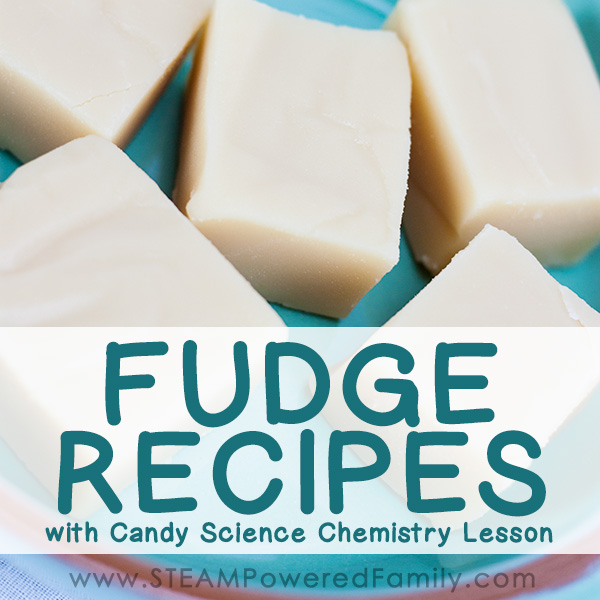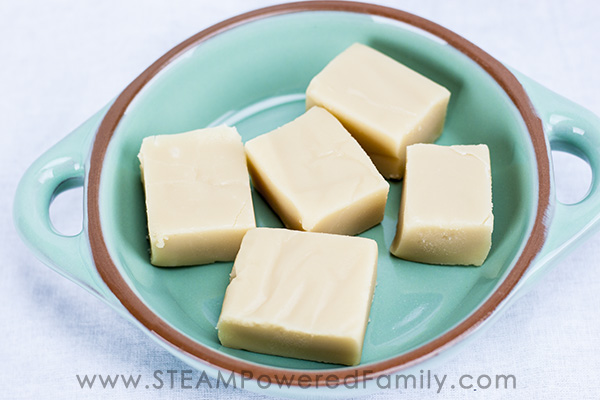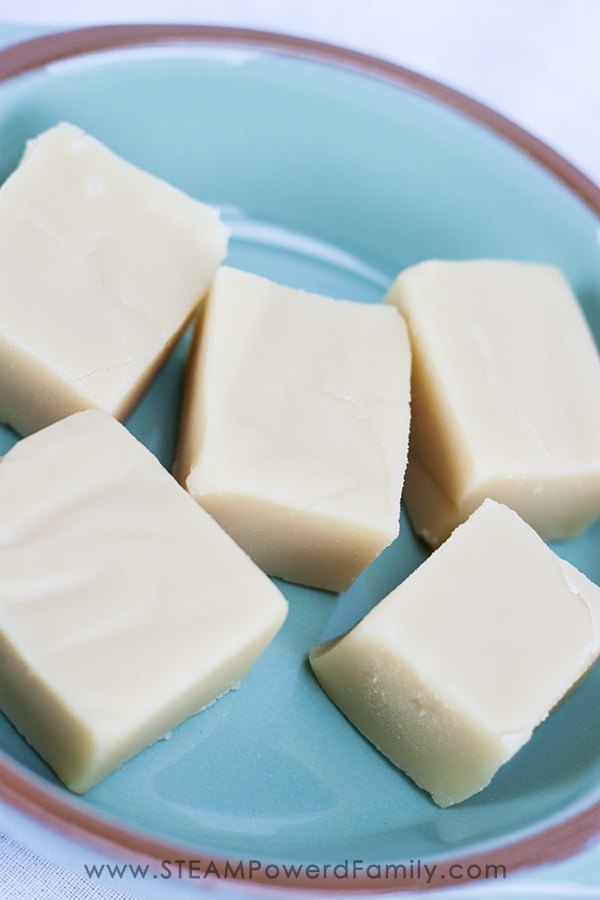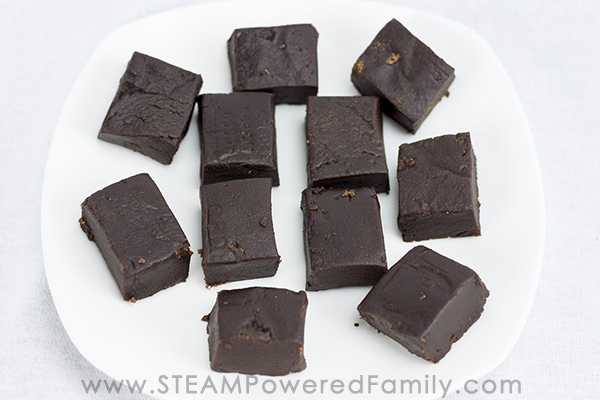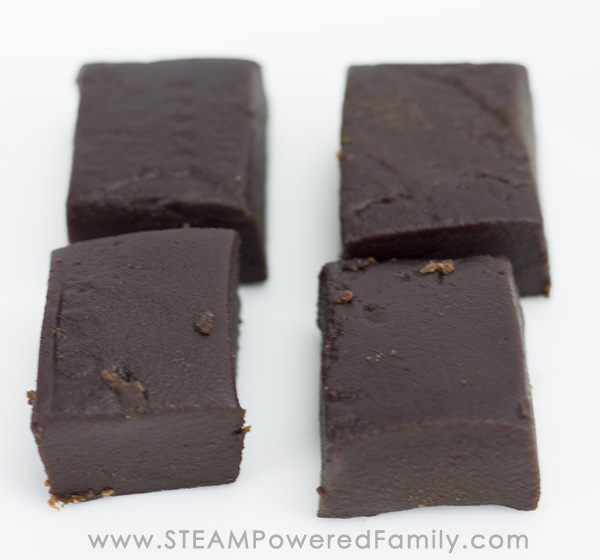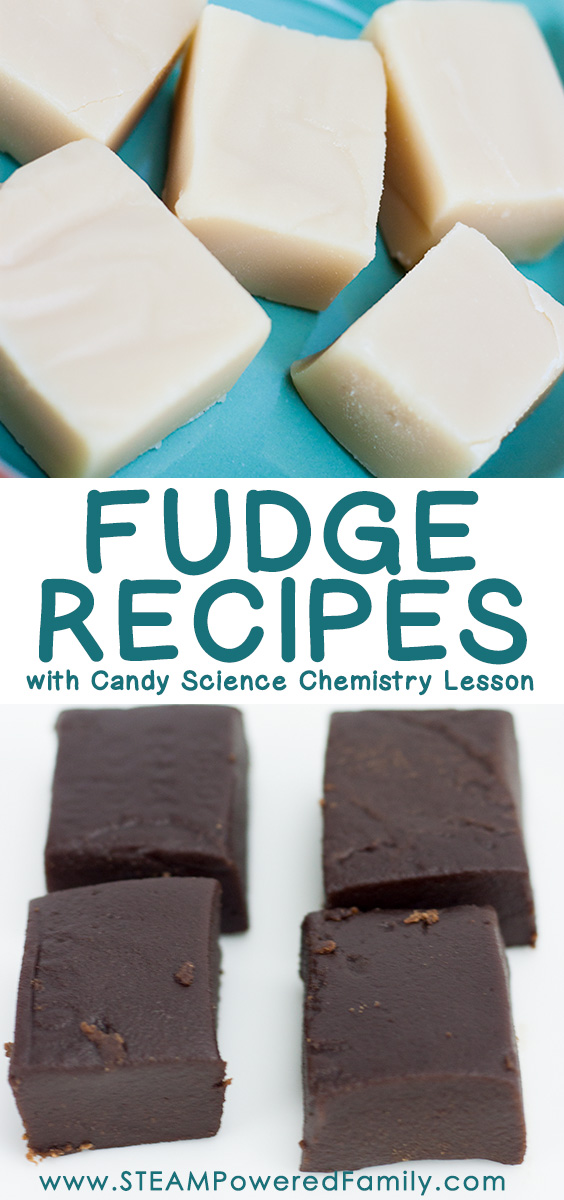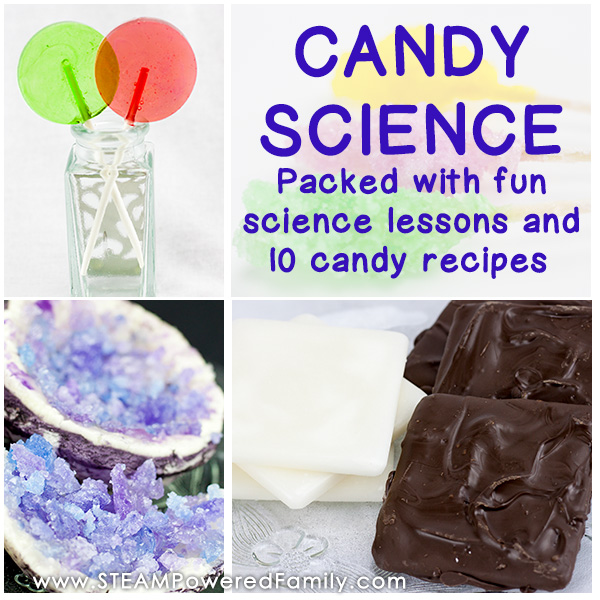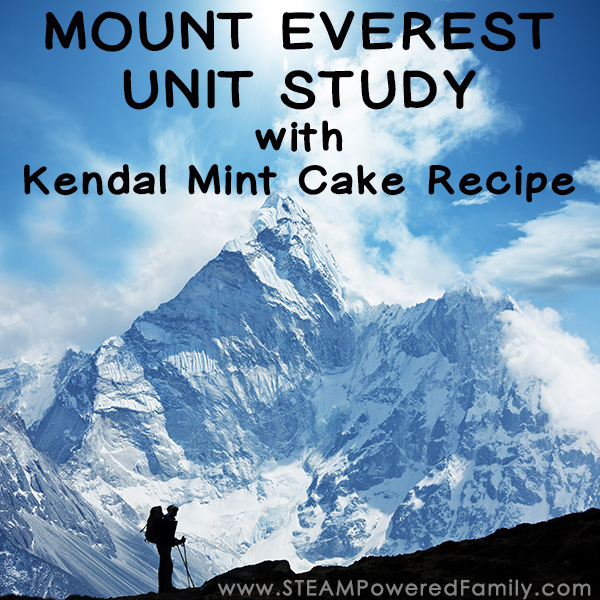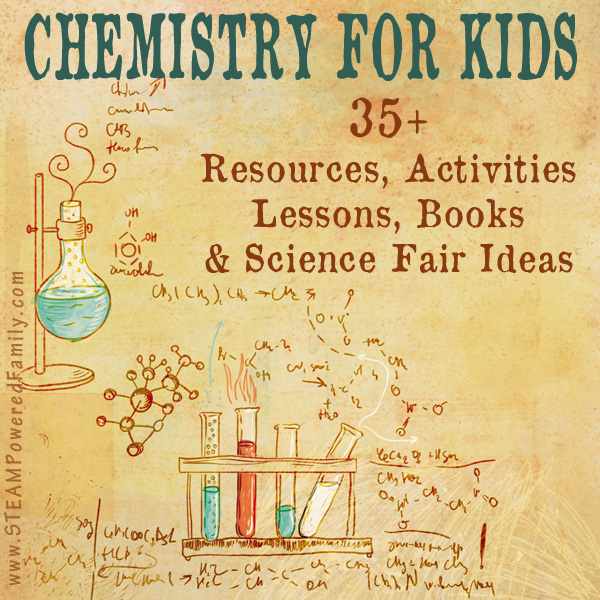Vanilla and Chocolate Fudge Recipe with a Science Lesson
Fudge is a delicious, creamy candy treat. Making it is a fascinating science lesson. Vanilla and chocolate fudge recipes are shared with the candy science.
One of my favourite treats growing up was fudge and to this day I love a good piece of fudge with my tea. The way it melts on the tongue, the combination of sweet and creamy, make it one of the best candy treats in my books. One day my mom decided to teach me how to make fudge. Good fudge. Really, really good fudge. With her permission I’m sharing all her secrets today along with the science behind fudge making. Because if you can make it educational the calories don’t count, right?
Disclaimer: This post contains affiliate links
Before we start I highly recommend you read this article on the science behind candy making. There are a lot of tips and tricks in there, plus a fascinating science lesson on candy making.
We decided to make two fudge recipes – Vanilla Fudge and Chocolate Fudge. Spoilers… the vanilla was my favourite! So I’ll start with the vanilla fudge recipe.
VANILLA FUDGE RECIPE
To Make Vanilla Fudge You Will Need
Tools:
4 quart saucepan
Stiff whisk
A large ceramic bowl (like mixing bowl)
A wooden spoon
A candy thermometer (make sure you test it for accuracy as described here)
8 inch baking tray lined with parchment or foil (or use a disposable version)
Vanilla Fudge Recipe Ingredients:
¼ cup of butter
3 cups of sugar
1 ½ cups of heavy cream
1 teaspoon of vanilla extract
Cuisinart MCP194-20N MultiClad Pro Stainless Steel 4-Quart Saucepan with CoverBest Manufacturers 12-inch Heavy Duty French Wire Whisk
DOWAN Ceramic Mixing Bowls/Serving Bowl Set – 3 Packs, Nesting Bowls
Polder THM-515 Stainless Steel Candy/Jelly/Deep Fry Thermometer
Sherri Lynne Home 8
Directions for Vanilla Fudge Recipe:
Add the butter, sugar, and cream to the saucepan and heat to a simmering boil, stirring constantly. Use medium low heat to avoid scorching the mixture.
Place the candy thermometer into the mixture making sure the bulb at the bottom does not touch the bottom of the pan.
Stop stirring the mixture at this point and allow the temperature to reach 116C / 240F. Watch very closely or you will burn your fudge.
Remove from the heat and carefully pour into a bowl. CAUTION: it is very hot!
The reason we pour the mixture into a bowl is to stop the syrup heating from the hot pan. It does require that you decant as smoothly as possible with no scraping of the pan. If you disturb or aggravate the mixture too much it will cause crystals to form before we are ready.
Let it rest for a few minutes and cool until the fudge reaches 80C / 176F.
Add the vanilla extract and begin to beat the mixture as it continues to cool.
Beat until the mixture thickens about 7 – 10 minutes. Did I mention this is science and a fitness test?
Once it thickens, pour it into the lined baking tray and allow to set. Setting will take 2 to 4 hours. Once set, cut into pieces and enjoy!
The Science Behind Vanilla Fudge Making:
Fudge is a crystalline candy meaning that we want crystals to form in our syrup. However, unlike rock candy, where we allow the sucrose crystals to grow large, we need to control the growth of crystals vigorously. We do this by adding butter and cream to inhibit the crystal growth and by beating the syrup as it cools down.
When chatting like a true Candy Scientist here are a couple of key science concepts:
1. We need to melt the sucrose (sugar) to 116 C / 240 F. This is known as the soft ball sugar stage in candy terms.
2. It is very important with fudge making to limit shaking, jiggling and aggravating of the fudge mixture as it cools. If you do it will trigger crystal formation and you will lose the creamy texture we love about fudge. Then, everything changes when it reaches the correct temperature for the crystals to start forming naturally during the cooling process. At this point we beat and mixture extensively until it thickens. This forces the crystals to form in a very specific way that gives us our delicious, creamy fudge!
CHOCOLATE FUDGE RECIPE
This recipe has a few extra little twists, it’s not just adding chocolate to the recipe, we need to make some other adjustments. That is because the addition of chocolate alters the chemistry of the fudge recipe and we need to adjust our science… and fudge making process… to accommodate for the chemistry changes.
Tools:
4 quart saucepan
Stiff whisk
A large ceramic bowl (like mixing bowl)
A wooden spoon
A candy thermometer
8 inch baking tray lined with parchment or foil
Chocolate Fudge Ingredients:
3 cups of sugar
½ cup of shaved unsweetened chocolate
1 ½ cups of milk
¼ cup of softened butter
1 ½ teaspoons of vanilla extract
Chocolate Fudge Directions:
Cover an 8 inch square tray with parchment or foil. Make sure to lap it over the edges. Set aside.
Mix the sugar and chocolate in a 4 quart saucepan then stir in the milk.
Heat the mixture until it starts to boil. Stir constantly.
Reduce the heat to low medium and continue cooking with a candy thermometer inserted into the mix until it reaches 115 C / 239F.
Do not stir during this part of the cooking, but keep a close eye on that thermometer. Another tip, don’t let the bulb of the thermometer rest on the bottom of the pan as this will skew the temperature readings.
Once it reaches the desired temp, remove the pan from the heat and pour into a clean mixing bowl.
Once again we are removing it from the hot pan to stop the continued heating of the fudge mixture. Since Chocolate Fudge is even more unstable than Vanilla Fudge be especially careful with this mixture to cause as little disruption as possible. If you do, it will start to crystallize prematurely.
Let it rest for a few minutes while the temperature lowers to 80-90C /176-194F.
Add the butter and vanilla.
Now start beating the mixture with a wooden spoon until the mixture is thick. This will take about 7 – 10 minutes.
Once it is thick , pour the chocolate fudge into the square pan and leave it to set. This will take 2 to 4 hours.
When it is ready, cut into pieces and enjoy!
The Science Behind Chocolate Fudge Making:
This is very similar to the Vanilla Fudge recipe but we are adding chocolate to the mix and this creates a slightly different scientific problem.
All types of fudge are a crystalline candy, meaning that we want crystals to form in our syrup. In fudge though we need to vigorously control the crystal formation process to ensure we get the wonderful, creamy texture we know and love in our fudge.
In chocolate fudge we do this using the chocolate, cream and the butter to inhibit the growth of crystals. You will notice that the mixture is a lot thicker than the Vanilla Fudge and it is a lot more unstable – meaning that crystals will form very quickly and easily. I highly recommend trying Chocolate Fudge once you have mastered Vanilla Fudge.
Also note, that we need to achieve slightly different temperatures a key points in the fudge making process to ensure your chocolate fudge recipe is a success. If you notice your Chocolate Fudge is a little bit gritty tasting, that means your crystals formed too large during the candy making process. If you continue to struggle check out this resource on tips for fudge making.


